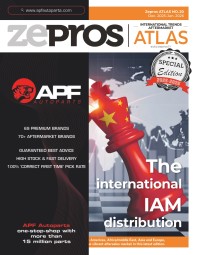
The aftermarket stays on track, with OE in a tailspin

It’s a rocky road indeed to technological transformation! With carmakers at a critical juncture and their original equipment suppliers caught up in the downward spiral of the times, everything in this environment spells danger. But the aftermarket planet is holding firm, buoyed more than ever by its venerated ageing fleet.
So far, so good! Judging by the sentiments of many of our interviewees, distributors and parts suppliers alike, 2024 was a good year for the aftermarket... with full year sales exceeding $600 billion worldwide (estimation) out of total automotive revenues of nearly $3,500 billion. This is a fine performance reflected in virtually every market on the planet, driven by a car parc that is getting older by the day at almost 12 years on average (albeit rejuvenated by the Chinese and Gulf States' fleets). But at this level, some suppliers are concerned that the fleet is actually ageing too quickly, pushing customer demand towards low-cost parts, which is hardly conducive to the profitability of the ecosystem in the medium term. The fact remains that the automotive aftermarket is still robust. But this tailwind is not blowing with the same intensity everywhere:
• The United States remains under pressure, with growth of 4.5%.
• European markets are holding up reasonably well, but once again showed signs of running out of steam in the final quarter. This raises fears of a more challenging 2025.
• The Chinese market is following the same trend, while India is outperforming on its scale (with a fleet of just under 50 million passenger cars).
As a result, premium suppliers are continuing to turn their attentions to Latin America, South-East Asia, the Middle East and, to a lesser extent, Africa, as promising growth drivers for the future. The global aftermarket is therefore continuing to gain ground, and the sector has every chance of reaching $1254 billion (parts and services, including tyres, consumer prices) by 2030, according to a projection by the consultancy McKinsey.
Beware the OE tsunami
But aftermarket divisions also need to invest.... Not an easy task when their management teams are squeezing budgets amid pressure from plummeting OE sales. Because at the end of the chain, the repairer must be able to continue to repair and therefore be served as effectively as possible by a high-performance distribution network which, for the time being, is holding up. But at the end of this chain, they need to work with parts suppliers who are in good health! The ecosystem therefore needs to mobilise to break this circle, which is beginning to turn vicious. And at the heart of this maelstrom is decarbonisation through fleet electrification. Automakers have embarked on this path out of necessity, and have ended up devoting a large proportion of their resources and R&D investment to it. They must also invest heavily in the software and digital development of vehicles. This investment is set to triple between now and 2035, accounting for 58% of R&D, according to a study by IBM's Institute for Business Value published at the end of 2024.
This equation is made all the more complicated by the fact that our Western manufacturers are falling behind due to a lack of technological competitiveness, which has resulted in European production falling by a further 25% since 2019 compared with China (source: Clepa). And Chinese manufacturers and equipment suppliers, the champions of electric vehicle production and competitiveness, are unlikely to be daunted by the rise in European and American customs duties as they seek to export their highly affordable vehicles to our markets on a massive scale. A bad signal, then, for the ‘incumbents’, who are cutting back! Volkswagen is planning to sacrifice tens of thousands of jobs in its German plants, Ford is reducing its workforce by 4,000 in Europe, and Stellantis has just announced that it is stopping production at its British factories.
OE suppliers destabilised
And as a ratchet effect, their OE suppliers will also have to fight to survive. There was a steady stream of bad news for the European automotive supplier industry in 2024. Valeo (175 plants worldwide) and Michelin announced two site closures in France. ZF is aiming to cut up to a quarter of its jobs in Germany by 2028, while Bosch is considering reducing its workforce by 5,500. And Sweden's Northvolt, a forerunner and European contender in the production of batteries for electric vehicles, has just filed for protection under US bankruptcy law. A total of 32,000 job losses were announced for the first half of 2024. These manufacturers are confronted with falling production volumes, reduced profitability and the need to invest in technological transition. The competitiveness of our European ‘champions’ is under pressure, and they now account for just 14.6% of global automotive value creation, down 2 points compared with 2019. According to a Clepa briefing, sales in the first half of the year fell by 4.6% to €187 billion, with margins below the crucial threshold of 5%. At this rate, the car industry could be heading for a downturn that is structural rather than cyclical, leaving it permanently lagging behind in the global race for the mobility of the future. These are therefore turbulent times for an automotive industry sector at risk of…electrocution!










